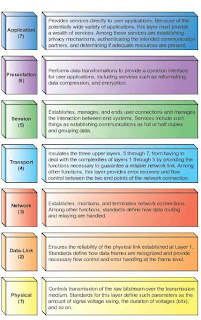Benefits
of subnetting
Reduced
network traffic
One network will not access the data
of other network without the use of router. Thus we can reduce the amount of
data remain in one network. Less data less overhead, collision, or broadcast
storm.
Optimized
network performance
This is a result of reduced network
traffic.
Simplified
management
It's easier to identify and isolate
network problems in a group of Smaller connected networks than within one
gigantic network. Facilitated spanning of large geographical distances Because
WAN links are significantly slower and more expensive than LAN links, a single
large network that spans long distances can create problems in every area
earlier listed. Connecting multiple smaller networks makes the system more
efficient.
Powers of 2
Powers of 2 are important to
understand and memorize for use with IP subnetting.
|
Before we go further
let’s get familiar with subnetting components
Subnet
mask
A subnet mask is a 32-bit value that
allows the receiver of IP packets to distinguish the network ID portion of the
IP address from the host ID portion of the IP address. Every IP address is
composed of a network component and a host component. The subnet mask has a
single purpose: to identify which part of an IP address is the network
component and which part is the host component. Subnet mask value 0 represent
host ID while subnet mask value 1 to 255 represents Network ID in ip address.
Classless
Inter-Domain Routing (CIDR)
This slash notation is sometimes
called CIDR (Classless Inter-Domain Routing) notation. It’s basically the
method that ISPs (Internet service providers) use to allocate a number of
Addresses to a company, a home—a customer. The slash notation is simply the
number of 1s in a row in the subnet mask. The real reason to use CIDR notation
is simply that it is easier to say and especially to type.
Address
Class and Default Mask
Subnetting happens when we extend
the subnet mask past the default boundary for the address we are working with.
So it's obvious that we first need to be sure of what the default mask is
supposed to be for any given address. When faced with a subnetting question,
the first thing to do is decide what class the address belongs to. And later
decide what the default subnet mask is. One of the rules that Cisco devices
follow is that a subnet mask must be a contiguous string of 1s followed by a
contiguous string of 0s. There are no exceptions to this rule: A valid mask is
always a string of 1s, followed by 0s to fill up the rest of the 32 bits.
(There is no such rule in the real world, but we will stick to the Cisco rules
here—it's a Cisco exam, after all.) Therefore, the only possible valid values
in any given octet of a subnet mask are 0, 128, 192, 224, 240, 248, 252, 254,
and 255. Any other value is invalid.
Block
Size
The process of subnetting creates
several smaller classless subnets out of one larger classful . The spacing
between these subnets, or how many IP addresses apart they are, is called the
Block Size.
Network
ID and Broadcast ID
The first address in a network
number is called the network address, or wire number. This address is used to
uniquely identify one segment or broadcast domain from all the other segments
in the network.
The Broadcast ID
The last address in the network number is called the directed broadcast address and is used to represent all hosts on this network segment. it is the common address of all hosts on that Network ID. This should not be confused with a full IP broadcast to the address of 255.255.255.255, which hits every IP host that can hear it; the Broadcast ID hits only hosts on a common subnet. A directed broadcast is similar to a local broadcast.
The main difference is that routers will not propagate local broadcasts between segments, but they will, by default, propagate directed broadcasts.
The last address in the network number is called the directed broadcast address and is used to represent all hosts on this network segment. it is the common address of all hosts on that Network ID. This should not be confused with a full IP broadcast to the address of 255.255.255.255, which hits every IP host that can hear it; the Broadcast ID hits only hosts on a common subnet. A directed broadcast is similar to a local broadcast.
The main difference is that routers will not propagate local broadcasts between segments, but they will, by default, propagate directed broadcasts.
Host
Addresses
Any address between the network
address and the directed broadcast address is called a host address for the
segment. You assign these middle addresses to host devices on the segment, such
as PCs, servers, routers, and switches.
